

 |
 |
|
#91
|
||||
|
||||
|
One thing to think about when using 44-gal drums in barriers/barricades - have two layers, the rear layer staggered so the drums fill the space between the drums of the first layer.
It's very easy for projectiles to slip between two barrels and the rounded shape even assists some projectiles to find that weak spot. |
|
#92
|
||||
|
||||
|
Quote:
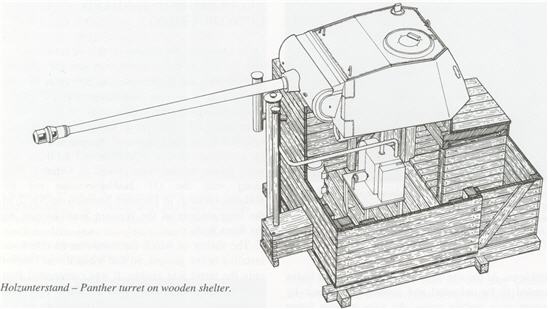 Quote:
Of course they never worked alone. They had a compliment of infantry to defend them and could call on nearby artillery. Like everyone in The Second World War the Germans were all about manouevre so these were a potent backstop to deal with breakthroughs. Last edited by ChalkLine; 08-21-2020 at 07:21 PM. |
|
#93
|
||||
|
||||
|
There's a few decent images floating around of various German turrets used as a road blockades, typically they're Panther turrets on Berlin streets (although in some cases, they dug in the entire tank, burying the vehicle up to the hull roof).
  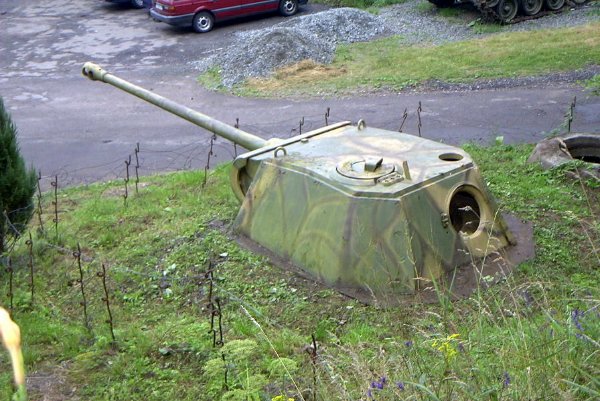
|
|
#94
|
||||
|
||||
|
The problem with isolated fortifications such as the Panzerstellung is you can smoke them and then infantry can sneak up with HEAT weapons.
In a T2K context it's unlikely you'll see many until the final phase of the war but before the total breakdown. You still need to lift the turret into place and tank turrets are seriously heavy and fortifications aren't always on level ground. The most likely final era versions would be the Holzunterstand "wooden stand" versions as they don't need heavy concrete or too much advanced technical and engineering ability. |
|
#95
|
||||
|
||||
|
I would also imagine that modern Soviet MBT turrets would not be suited to Panzerstellung type fortifications because of their integral auto-loading systems. I assume it would need some sort of generator or external power source to remain functional? Can the auto-loader be removed and the canon remain operational (yet manually-loaded)?
-
__________________
Author of Twilight 2000 adventure modules, Rook's Gambit and The Poisoned Chalice, the campaign sourcebook, Korean Peninsula, and co-author of Tara Romaneasca, a campaign sourcebook for Romania, all available for purchase on DriveThruRPG: https://www.drivethrurpg.com/product...--Rooks-Gambit https://www.drivethrurpg.com/product...ula-Sourcebook https://www.drivethrurpg.com/product...nia-Sourcebook https://www.drivethrurpg.com/product...liate_id=61048 Last edited by Raellus; 08-21-2020 at 11:13 PM. |
|
#96
|
||||
|
||||
|
I'm not stating that you wouldn't see Panzerstellung in the Twilight War, but one reason that they featured in the waning days of WW2 is that German manufacturing in the last months of the war* was so disrupted by allied bombing that they were having a hard time producing entire tanks, and fuel was in very short supply for the same reason. Chassis/engines were harder to manufacture that turrets, and there wasn't enough gas for new tanks anyways, so homeless turrets were used in fixed fortifications instead. In the Twilight War, manufacturing would be disrupted much more abruptly, so you probably wouldn't end up with as many "surplus" turrets as the Germans did during the last six months or so WW2. I reckon Panzerstellung would be a lot less common in WWIII than in its predecessor.
*Panzerstellung featuring obsolete tank turrets armed with MGs and light canon (Tobruks, I think they were called) were constructed and employed earlier in the war (like in some of the Atlantic Wall defenses). I know that in some parts of the Soviet Union and Switzerland, of all places, obsolescent tank turrets were emplaced in fixed fortifications defending strategic passes and such. -
__________________
Author of Twilight 2000 adventure modules, Rook's Gambit and The Poisoned Chalice, the campaign sourcebook, Korean Peninsula, and co-author of Tara Romaneasca, a campaign sourcebook for Romania, all available for purchase on DriveThruRPG: https://www.drivethrurpg.com/product...--Rooks-Gambit https://www.drivethrurpg.com/product...ula-Sourcebook https://www.drivethrurpg.com/product...nia-Sourcebook https://www.drivethrurpg.com/product...liate_id=61048 |
|
#97
|
||||
|
||||
|
Actually a lot of the Panzerstellung were specially-built turrets with thicker overhead armour to resist artillery (classic military mindset: "we have a problem: Fire lots of cannons at it.")
While you can remove the autoloaders from many soviet cannons it's probably not necessary. Modern turrets tend to be huge (even though the bustle racks and stowage will probably be left off) and you'll need a generator to efficiently turn it to respond to threats. That and they have a lot of electrical systems in them anyway. Turret-bunkers have an interesting history. I'm just reading "Tank Turret Fortifications" Neil Short (Marlborough, 2006) ISBN 978 1 84797 367 2 * which is available for fifteen bucks as an e-book (*Okay for a good popular history work. The facts are good but Short's conclusions often seem a bit iffy) |
|
#98
|
||||
|
||||
|
If you're reusing one of those old Second World War bunkers with a tiny interwar turret on top it'd perfectly fit an automatic grenade launcher in place of the old cannon . . .
|
|
#99
|
||||
|
||||
|
This one will be a bit long.Don't go to its website as it's been hacked.
I'm posting some info on Port Scratchely. Now, this is as far from the battlefields of Twilight 2000 as you can get but it's a good basic plan for a coastal fortification built on a headland. It's a Victorian-era coastal battery guarding a port. It was updated during The Second World War. I won't go into its history. Its usefulness lies in that it is representative of a lot of fortresses just like this and could be found anywhere in the world.  The Aboveground Section 1. Entrance to Fort Scratchley 2. Dry Ditch and Defensive Wall - the ditch was a major obstacle for any attack against the fort from the landward side. 3. The Old Guardhouse - Contained two cells for locking up misbehaving soldiers and was the crew station for soldiers guarding Fort Scratchley - it was converted into a communications centre during World War 2. 4. The New Guardhouse - Built during World War 2 to replace the Old Guardhouse, it also contains two cells and had an Anti-Aircraft machine gun mounted on the roof during, World War 2. 5. The Laboratory - a safe area where shells and cartridge bags were filled with gunpowder from the wooden barrels that the powder was transported in. 6. Ablutions and Stores Block - Added before World War II to provide additional shower and toilet facilities as well as more storage space for rations and clothing. 7. The Gunner's Toilets - originally this block housed the toilets for the gunners and the Non Commissioned Officers at Fort Scratchley. 3. Searchlight Engine Room - Built during World War 2 to house and protect a Lister diesel powered D.C. Generator used to power a searchlight, which was mounted below the fort. 9. Mine Firing Station - Range-Finding and Control Position for the remote controlled minefield, which could be laid across the harbour entrance in times of war. 10. The Barracks - accommodation area for the Permanent Military Forces personnel. (The militia forces had to sleep in tents outside the fort walls when they had their annual training camps. 11. Canteen and Stores Block - contained the soldier’s canteen or mess (dining area). 12. Kitchen Block - contained the kitchen, washhouse, storerooms and offices. 13. Commandant's Cottage - residence for the senior Permanent Military Forces Officer, his family and servants. During World War 2, it was the Officer's Mess and their Barracks. 14. The Western Barbette - an 80 pounder Rifled Muzzle Loading (R.M.L.) Gun was mounted in this gun pit from 1882 to 1907. The main 9 inch R.M.L. Guns at Fort Scratchley were mounted in similar pits to this, facing out to sea, when the fort was first constructed in 1882. 15. The Battery Observation Post - constructed in 1914 and extended during World War 2, this was the command centre and range finding position for the fort and the new 6 inch Mark VII guns. In 1943 it was extended to house the Searchlight Directing Station. 16. Casemate Air Shafts - these wrought iron covers protect the airshafts leading down to the, casemate battery. These, shafts also gave access for the installation and later removal of the guns from the underground casemate battery. 17. The Parade ground - area for the parading and drilling of the gunners. 18. No.'s 1 & 2 Guns - these 6-inch Mark VII Breech Loading (B.L.) Guns were installed in & 1910-11 and helped to protect Newcastle during both World Wars. On the morning of 19th June 1942, they were used to fight off a Japanese Submarine attacking Newcastle. 20. Flagpole - replica of the original flagpole for National and Signal Flags. 21. Entrance to the Underground Passageways. 22. The Artillery Store - Main Storeroom for the fort. 23. Searchlight Directing Station - 1941 to 1943 the fort's three, searchlights were controlled from this position, and it was transferred to the Battery Observation Post in 1943. 24. Auxiliary Searchlight Engine Room - a wartime measure, this position mounted a Gardener No. 9 Heavy Oil Engine and a belt driven D.C. Generator for additional power during the war. 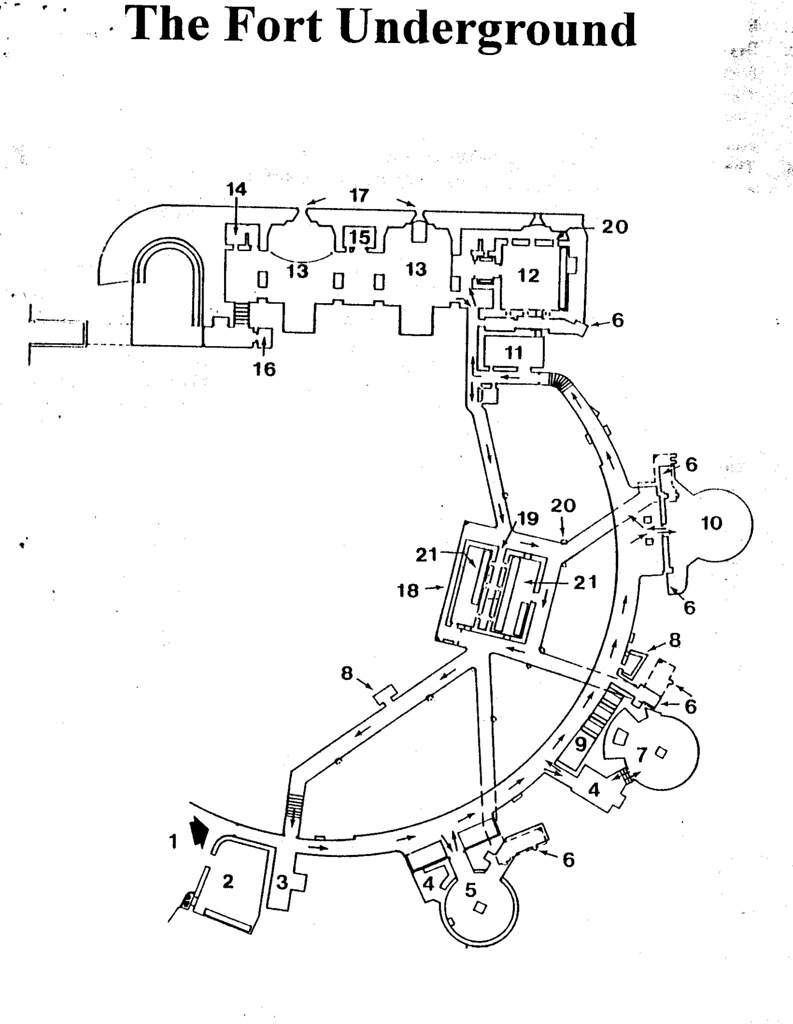 The Underground Sections 1. Entrance to the original Gun Emplacements and Magazines. (The Tunnels) 2. Artillery Store - The Fort's Storeroom (oils, paint, tools, uniforms, tools and other stuff@. 3. Small Arms Store - original storage area for the Martini-Henry Rifles used by the troops. 4. Side Arms Store (1890 - 1937) - storage area for gun sights, breech fittings and loading tools for the disappearing gun. 5. Gun Emplacement No. 1 (1882 to 1937) 1882 - 1890 One, 9 inch Rifled Muzzle Loading (R.M.L.) Gun in an open barbette 1390 - 1937 One, 6 inch Breech Loading (B.L.) Gun on a Hydro-Pneumatic (H.P.) "Disappearing" type mounting. 1940 - 1962 Pit roofed over after removal of gun-used for additional shell storage area. 6. Ammunition Lift -- used to bring Shells and/or Cartridges up from the magazine level 7. Gun Emplacement No. 2 (1882 - 1937) 1882 - 1940 As for Gun Emplacement No. 1 (See 5) 1940 - 1945 Roofed over and used as gun crew-sleeping area during World War 11. 8. Lamp Room - used to store, maintain and light the kerosene, lamps used in the tunnels. 9. Crew area - No. 2, 6 inch Gun was manned 24 hours/day during wartime as the "Examination Gun" to enforce the Naval Control of shipping entering and leaving the harbour during World Wars 1 & 2. 10. Gun Emplacement No. 3 (1882 - 1910) 1882 - 1910 As for Gun Emplacement No. 1 (See 5). 1910 - 1962 gun removed, pit roofed over to serve as main shell store for the new &inch Mark VII B.L. Guns 11. Shell Store - shell storage area for the original R.M.L and later Disappearing Guns. 12. No. 1 Casemate Battery (1882 to 1962) 1882 - 1898 One, 80 pounder (pdr) R.M.L. Gun. 1898 - 1910 one, 1.5 inch Nordenfelt Quick Firing (Q.F.) Gun (Anti-Torpedo Boat Gun). 1910 - 1962: Converted to a Cartridge Magazine for the No. 2, 6 inch Mark VII Gun. 13. No.'s 2 & 3 Casemate Battery (1882 to 1918) 1882 - 1898 As for No. 1 Casemate Battery (See 12). 1898 - 1918 one, 1.5 inch Nordenfelt Quick Firing (Q.F.) Gun (Anti-Torpedo Boat Gun). 14. Expense Magazine - ready use ammunition for the Casemate Battery Guns. 15. Shell Store - ready use shells for the Casemate Battery Guns. 16. Time Gun Ammunition Store - a time gun was fired at 1 o'clock each day from the fort. 17. Casemate Gun Ports - The Casemate Battery guns provided short-range defensive fire to protect the harbour entrance and the minefield across the channel. 18. Ventilation Passage - allowed the circulation of air to prevent dampness coming through the walls and effecting the gunpowder stored in the magazines. 19. Lamp Passage - external access to the kerosene lamps used to light the magazines 20. Lamp Recess - glassed in fittings for the kerosene lamps to ensure that the flame from the lamps couldn't ignite the gunpowder cartridges stored and handled around the magazines. 21. Main Magazines (1882 - 1962) 1882 - 1892 Gunpowder cartridges for the 9-inch & 80 pdr R.M.L. Guns. 1892 - 1910 Gunpowder and Cordite Cartridges for the 6 & 8 inch Disappearing Guns. 1910 - 1962 Cordite Cartridges for the 6 inch Mk VII B.L. Guns.  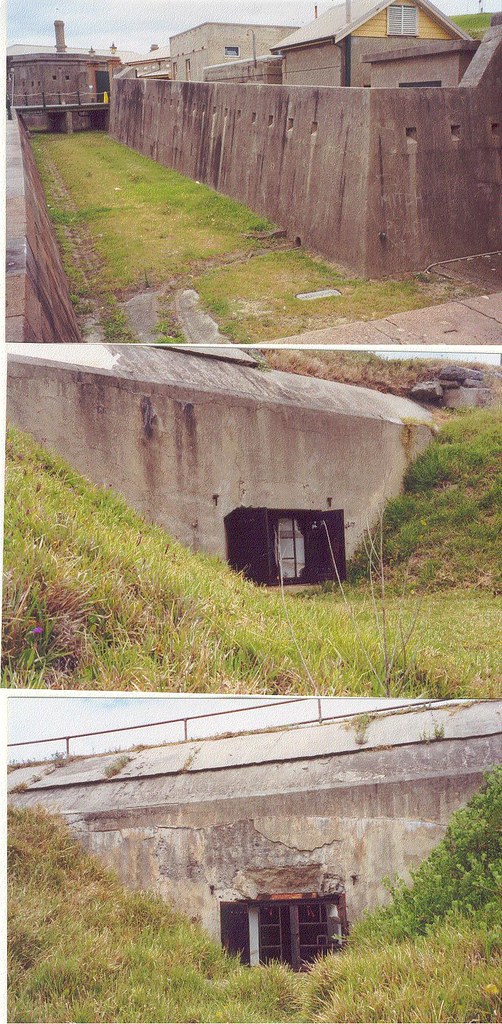 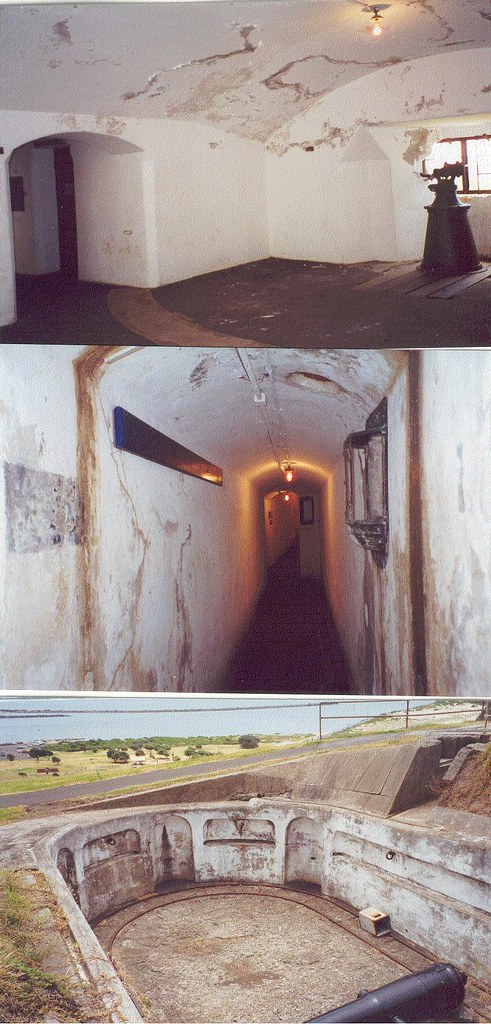      Here are its Google Maps coordinates so you can get an idea of how it relates to its surroundings Last edited by ChalkLine; 08-22-2020 at 02:41 AM. |
|
#100
|
||||
|
||||
|
The disappearing gun mount pits, now vacant, make perfect positions for heavy mortars. The soviets love heavy mortars, here's a good place to have a few.
The dry ditch is still a serious impediment to attack but if I was the GM and it had been manned during the war I'd have enlarged it and have had the forward wall clad in sandbags revetted with wood and maybe covered in chain-link. Failing that keep it as it is and have a stand-off chain-link barrier mounted one metre off the face of the concrete. As can be seen some of the heavy armour covers are starting to look a bit rusty. A wooden framework supporting a metre or so of sandbags will fix that and stop the covers shedding steel splinters should they be struck by artillery. There's a lot of uses for this fortress but a good one is to have it holding hostage the port below. Marauders can have a few odds and sods direct fire weapons in the casemates covering the harbour and stopping enemy shipping forcing the straights. This was going to be my plan for it (either that or a murder mystery in Space 1889) |
|
#101
|
||||
|
||||
|
I been thinking you make some good fortications using
Barrells (Plastic or metal) filled with sand, dirt or small stone Landscaping Stone Large Logs ammo can filled with sand or dirt or pack snow with a little water added
__________________
I will not hide. I will not be deterred nor will I be intimidated from my performing my duty, I am a Canadian Soldier. |
|
#102
|
|||
|
|||
|
A recent example of military use of Hesco https://www.thedrive.com/the-war-zon...sses-in-africa
|
|
#103
|
||||
|
||||
|
Quote:
A 55 gal drum would be better used storing day's worth of water for a platoon, the methanol to keep vehicles moving, or components of stills or water filters than static fortifications. Of course rusted out or shot up barrels you'd use for gabions but you wouldn't waste any in good condition. |
|
#104
|
|||
|
|||
|
Another existing fort that could be of use in a campaign involved in the Gulf of Mexico (whether that follow on from Spanish Main, Urban Guerilla, or Red Star) is Fort Jefferson. The third-largest fort in the United States, it takes up 70% of the land area of Garden Key, Dry Tortugas, about 70 miles west of Key West. The fort's parade ground is 13 acres, surrounded by six brick-and-concrete walls that are eight feet thick and forty-five feet high. It's large enough to house 2,000 people and 450 cannon, and contains around 16 million bricks.
The fort was built for its strategic location and harbor. The inner harbor was deep enough for line-of-battle ships, but its entrance was only 120 yards across. The island already had a lighthouse, which the fort was built around (it was later torn down and another lighthouse built). It provided for a secure harbor from which to patrol the Gulf of Mexico and the entrance to the Straits of Florida. It's much more open now than it was originally; all of the gun embrasures were fitted with Totten gunports. The eight inch thick iron shutters were balanced so that the gasses leaving a cannon's barrel before the shot would push them open, with the shutter rebounding closed after the shot passed through. Over a century and a half, they were damaged by water and began cracking the fort's facade by swelling, so they've been removed. A would-be pirate king would want to find ways to fill some of that open area with protective cover. The one weakness of the location is a lack of fresh water. The design attempted to solve this by placing columns of sand within the walls of the fort, leading to cisterns below, so that rainwater falling on the fort would drain through the sand as a filtration medium. Unfortunately, the sand that was used contains mineral salts, so the water is undrinkable, though it can be used for washing or cooking if the cracked cisterns (from settling) can be patched. When the fort saw its heaviest use during the Civil War, steam condensers were used to produce water, and a post-Twilight War occupier would need some sort of method of producing drinkable water, possibly salvaged from ships.
__________________
The poster formerly known as The Dark The Vespers War - Ninety years before the Twilight War, there was the Vespers War. |
|
#105
|
|||
|
|||
|
using old sea land vans filled with dirt. you would need to do some bracing but thank about a two of three layer van. the bottom two are "solid" but the top one has heavy still plate on the inside and when the top guards drop down from the top of the top layer into the number 3 to fire at heavy attackers.
|
|
#106
|
|||
|
|||
|
Quote:
I wouldn't fill tires to make fortifications either. In modern war, a single flaming round will ignite those tires and they will burn INTENSELY, producing a choking poisonous smoke to boot. However, using them as a flaming barricade IS a viable tactic as the Skinnies proved in Somalia. Last edited by swaghauler; 08-23-2020 at 03:47 PM. |
|
#107
|
|||
|
|||
|
Using sea cans welded together with firing ports cut in could be a good option for cover, sand bags to help reinforce. One thing Ive used in my campaigns is jersey barriers. Easy enough with a crane or forklift to remove from hiways and construction sites and stack able. In our local cement plant they have walls made with the large brick like lego cement blocks. Many of the cement plants here make and use them in there yards especially the landscaping yards to keep rock and dirt separated and they have hooks in them to lift and place them. there about 2 feet tall and wide by 4 feet long.
|
|
#108
|
|||
|
|||
|
Sea cans would be good with sandbags on the outside and the inside, not to mention some chain link to act as " heat killer", and you have a viable keep. You would need to incorporate grenade sumps and ammo storage, and some way to prevent water infiltration.
The only real problem is how do you move them, cut holes, and make them into fortifications without power tools, lift trucks or boom trucks? To be sure, they could be nudged about by tracked vehicles, but we are really talking about precision emplacement, and nudges (burning precious fuel) are only broad strokes. Sandbags, sharpened stakes, shovels, axes, saws and picks with be the bastion makers of this era, coupled with copious amounts of manual labour. |
|
#109
|
|||
|
|||
|
Quote:
|
|
#110
|
||||
|
||||
|
A 20-footer weighs about 2 tonnes and a 40-footer weighs about 4 tonnes. These are well within a lot of load ranges for a derrick. You can build a big A-frame and get a trailer under it. You'll need chains, winches and cargo handling knowledge.
Now, trailers tend to have been left on nice flat ground but of course people are going to want them elsewhere. At this point you'll want as you said a crane. However by 2000ad they're everywhere (my players are looking for one now) and craning stuff around is bread-and-butter work for most people by the time 2000ad rolls around. By the way, those containers use Weathering steel (often known as "Cor-Ten" which is a trademark). While this stuff rusts slowly your player-made welds will rust at a normal rate unless they use specialist equipment which really isn't worth the bother. The walls are generally just under 2mm thick of mild steel equivalent. |
|
#111
|
||||
|
||||
|
Just some more on tank turrets being used for fortifications, Austria apparently had quite a few built into their Schleinzerwall bunker system.
Austria maintained a vast array of older tank turrets emplaced in fortifications. According to this site, Austria had: 48 75mm turrets (M4?), 24 85mm T-34 turrets (perhaps as many as 44), 56 83.4mm (20lb) Charioteer turrets, 143 90mm M36 turrets, 148 105mm Centurion turrets bought around 1980, plus another 226 105mm Centurion turrets after 1985. This quote is taken from the Austrian OOB provided in the thread about Raellus' Austria sourcebook. https://forum.juhlin.com/showthread.php?t=4178 Post #27 - however the link to the source of this info is now a dead link but the following link has some supporting information: - https://www.unterirdisch-forum.de/in...tsching.15479/ The construction work on the bunker line, which was also called "Schleinzerwall" (Karl Schleinzer: Minister of Defense from 1961 to 1964; note), with its permanent structures and other fortifications, was largely completed by 1964. During the Cold War, this wall was considered first line of defense and bulwark for a possible attack from the east - specifically from Hungary. Between the Danube and Wiener Neustadt, a total of around 140 systems of different sizes and with different armament were built ... The "Schleinzerwall" was built even before the spatial defense existed, as a reaction to the Hungarian crisis of 1956. Its construction established the permanent defense systems in Austria during the Cold War. These were built increasingly from the 1970s as part of the space defense concept. The facility on the Ungerberg was integrated into this concept and is therefore also a witness of this era . Armed Forces - TRUPPENDIENST - Issue 4/2015 - Ungerberg Bunker - Relic of the Cold War This quote is taken from the same site linked to from the first quote, page 2, post #26 https://www.unterirdisch-forum.de/in...g.15479/page-2 |
|
#112
|
|||
|
|||
|
Sweden used old tank turrets (37 or 75 mm) for defence of airports and coastal defence. IIRC 37 mm was used on airport, enough penetration to ruin a BMD crew's day. 75 mm was used in both roles.
75 mm: 
|
|
#113
|
|||
|
|||
|
Quote:
https://youtu.be/E5pZ7uR6v8c?t=90 |
|
#114
|
|||
|
|||
|
https://www.thedrive.com/the-war-zon...sses-in-africa
Here in the US one could see civil war era forts being reused especially if they were restored as a historic site. Or if one of the PC was a history major they could whip up something like the link quick enough. |
|
#115
|
|||
|
|||
|
Quote:
Fort Jay (New York, NY) - built 1794 on Governors Island. Castle Williams (New York, NY) - built 1807 on Governors Island. Fort Schuyler (New York, NY) - built 1833 at Throggs Neck. Fort Tompkins (New York, NY) - built 1847 to protect the landward approach to the harbor forts. Fort Delaware (Pea Patch Island, DE) - built 1817. Fort Gaines (Dauphin Island, AL) - built 1821. Fort Morgan (Gasque, AL) - built 1818. These two forts together protected the entrance to Mobile Bay. Fort Independence (Boston, MA) - built 1833 on Castle Island. Fort Warren (Boston, MA) - built 1833 on Georges Island. Fort Jackson (Plaquemines Parish, LA) - built 1822. Fort St. Philip (Plaquemines Parish, LA) - built after War of 1812 on the site of an earlier fortification. Only accessible by boat. Floods at high tide due to erosion of a protective levee. These two forts protected the entrance to New Orleans. Fort Knox (Prospect, ME) - built 1844. Only partially built, protects the mouth of the Penobscot River. Fort Massachusetts (West Ship Island, MS) - built 1859. A brick-and-mortar sea fort, the brick was unrestored between the fort's completion in 1866 and a program in 2001. Fort McHenry (Baltimore, MD) - built 1798. Fort Mifflin (Philadelphia, PA) - built 1771 as Fort Island Battery. The only active military base in the US older than the Declaration of Independence. Fort Moultrie (Charleston, SC) - built 1776. Castle Pinckney (Charleston, SC) - built 1810. Mostly in ruins. Fort Sumter (Charleston, SC) - built 1829. Fort Point (San Francisco, CA) - built 1853 to protect the harbor. Fort Popham (Phippsburg, ME) - built 1861, never finished. Protects the mouth of the Kennebec River. Fort Preble (South Portland, ME) - built 1808, site of Southern Maine Community College since 1952. Fort Gorges (Portland Harbor, ME) - built 1858, only accessible by boat. Fort Scammell (House Island, ME) - built 1808. All three of these forts defended Portland's harbor. Fort Pulaski (Savannah, GA) - built 1829. Fort Rodman (New Bedford, MA) - built 1857, never finished. Fort Sewall (Marblehead, MA) - built 1742. Fort Trumbull (New London, CT) - built 1839 on the site of a 1777 fortification.
__________________
The poster formerly known as The Dark The Vespers War - Ninety years before the Twilight War, there was the Vespers War. |
|
#116
|
|||
|
|||
|
For those of you playing Allegheny Uprising, Ft. Ligonier sits southeast of Pittsburgh on RT 31 and just 2 miles east of I76E (Toll) south of New Stanton and north of Johnstown. It is fully restored and dates to the French & Indian War.
https://youtu.be/mNuu4ozZO6A Swag |
|
#117
|
|||
|
|||
|
Quote:
There's also Fort Roberdeau outside Altoona, which was reconstructed in 1976 for the Bicentennial. Fayette County has the reconstructed Fort Necessity, which I've visited for a reenactment day. It would be totally unsuitable in a post-apocalyptic scenario. It was built to protect a storehouse from friendly looters, rather than as a battle fortification. It's made of thin planking and is barely large enough to contain a supply shed, no barracks or any bastions or anything of that sort. Virginia would have few ready fortifications. Fort Monroe, Fort Norfolk, and Fort Wool would all likely suffer damage if not destruction in the nuclear exchange. The only other fortification I know of in good shape is the earthwork Fort Ward in Arlington, which is 90-95% preserved (including embrasures, though I'm not sure of the condition of the magazines) as a city park and museum. Not relevant for T2K but of interest for history buffs is that the museum at Fort Ward has one of only three surviving Hale rocket launchers in the US. Maryland has a few potentially useful forts. Fort Frederick out in Washington County is a stone star fort right on the Potomac River. It's not designed to resist artillery, but it would be a useful fortification. I've visited this one and it would need work to rebuild the earthen platforms in the bastions, but it looks quite usable. One oddball is Fort Carrol, an abandoned seafort in Baltimore Harbor. It's been abandoned since 1921 except for use as a firing range during WW2. Outside of DC is Fort Washington, built in the early 1800s to guard the Potomac. There's a stone-and-brick fort and three surviving concrete and steel Endicott batteries (out of eight originals). I haven't visited this one, but it's on my to-do list once it fully reopens (it's currently closed to vehicular traffic because the trails are in heavy use by locals).
__________________
The poster formerly known as The Dark The Vespers War - Ninety years before the Twilight War, there was the Vespers War. |
|
#118
|
|||
|
|||
|
Another one to add to the list is Fort Snelling
https://www.mnhs.org/fortsnelling It also had a bunch of latter added building post Civil war and up to WW2. I live near this one if anyone needs more info or pictures. The state historical soc took over in the 70s and ran it as living history site. Last edited by Wolf sword; 08-31-2020 at 05:54 PM. Reason: adding more info |
|
#119
|
|||
|
|||
|
Another one I didn't see listed is Fort Niagara.
https://www.oldfortniagara.org/ |
|
#120
|
|||
|
|||
|
Quote:
|
 |
| Tags |
| poland |
| Currently Active Users Viewing This Thread: 1 (0 members and 1 guests) | |
| Thread Tools | Search this Thread |
| Display Modes | |
|
|